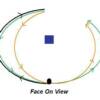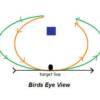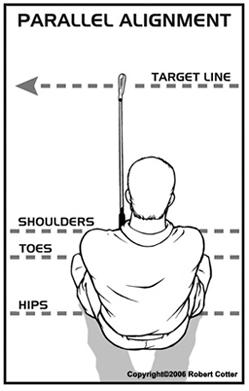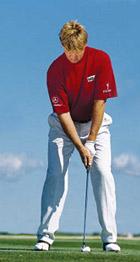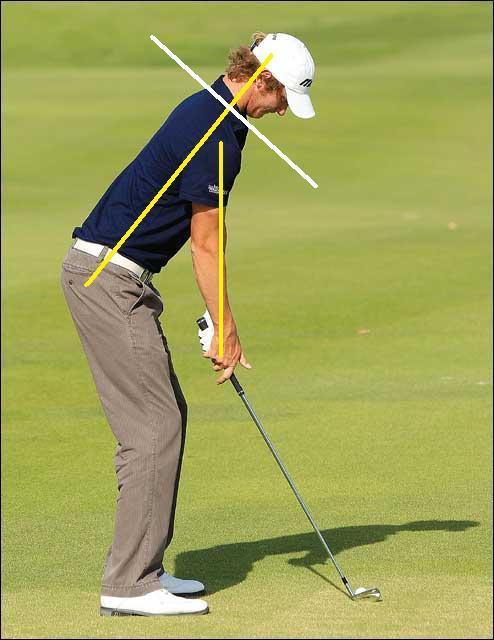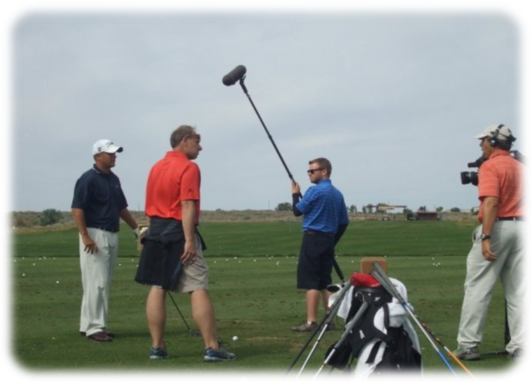Shoulders
The position of one's shoulders plays a major role in the shape and direction of both swing arcs. It is this reason that 'shoulders' are 1 of the 3 main chapters of the On Plane Swing. The position of your shoulders is directly influenced by your posture , particularly spine angle. From the 'face on view' your shoulders are parallel to the ground or perpendicular to your spine (well almost, the right shoulder is a touch lower than the left due to the position of your right hand being lower on the golf club). The shoulders are also parallel to the target line when viewed from above (and again perpendicular to your spine). Why? Very simply... this is where we want the shoulders at impact (or as close as possible). So, let's encourage the muscle memory by starting that way.
As I reiterated many times already, the only position we ultimately worry about is the correct impact position. The correct impact postion is easier to attain if we start correctly from the beginning. Your body is a creature of necessity and adaptation. It will do whatever it needs to in order to achieve results. Now, if your swing has less needs (compensations) then it will become very efficient. So, we start with the correct posture and set up positons. The perpendicular position to your spine your shoulders start at address is maintained throughout the back swing and forward swing arc. The major and most common flaw I see among good golfers is at the start of the foward swing arc. The head remains stationary and the hips move laterally to the target. When this happens the right shoulder (for right hand golfer) will move vertically downward (drop) and the direction of the forward swing arc has moved to the right of your intended line. Why is this so common? We were taught this way for a long, long, time...swing from the ground up.... start the foward swing with your hips and legs... keep your head stationary and fire the hips, etc. I was taught this as well. Also to be noted, the major flaw I see among mid to high handicap golfers is the exact opposite. At the start of the foward swing, there is no lower body drive and the right shoulder actually will rise just a bit and the 'over the top' motion is achieved. Now, I will point out something very important... I am not by any means suggesting that you start your forward swing with the hands or shoulders, I'm merely suggesting that one is as inefficient as the other.
Transition: I can't stress enough how important the transition from back swing to forward swing is for a successful golf swing. My video will demonstrate better than words can. Basically, at the start of the forward swing, you must strive for equal participation between the upper body and the lower body. One does not dominate or control the other. One does not start before the other. It is a simultaneous move between the lower body and the upper body. If one dominates the other... you'll be in compensation land forever.
I can categorize just about every golfer into 1 of 2 shoulder movements. The 'over the top' ers comprise about 95% of the golfing public (mid to high handicap golfer). The 'under/spin/flip' ers comprise about 5% of the golfers (low handicap to scratch golfer). Most of your tour professionals are in the smaller category. In order to have a repeating and efficient golf swing we must make the transition from back swing to forward swing a simultaneous move between the upper body and lower body. This simultaneous move will keep your shoulders 'on plane' and more importantly, 'level', at impact. For most everyone this will feel completely polar opposite of normal and correct. But, what you feel and what is real in golf are not the same. Keep this in mind when you make any change. There are specific swing drills to alleviate both problems.
For the 'over the top' ers, the video above will feel like you are swinging like Jim Furyk (is that such a bad thing?). For the good players, the 'under spin flip' ers video will feel like your are grooving the worst 30 handicap over the top move you can. Keep in mind, what you feel and what is real are not the same. You have to mentally accept this and keep doing the drills.
By leveling the shoulders at impact (shoulders parallel to the ground and parallel to the target line as possible) we achieve several things. One, the 2 swing arcs will be on a very similar plane (less compensations). Two, the club head is attacking the ball at a more desirable shallow angle of attack (more solid contact and more ball speed). Three, the club head is attacking the ball at a much less directional angle of attack (down the line instead of too far from the inside). As I touched on earlier in this section...there needs to be a simultaneous move with the upper body and lower body to start the forward swing. This move will continue right through impact and onto the finish. This movement is called the dynamic transfer of weight.
'Stop the 'Under/Spin/Flip' , learn how to cover the golf ball
(double click to expand)
"What Swing Transition Are You?
(double click to enlarge)
Stop the 'Over the Top' move
(double click to expand)
